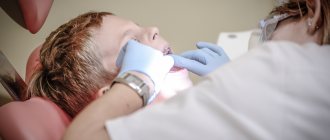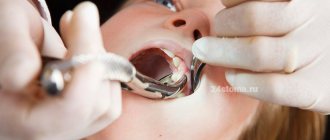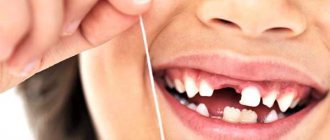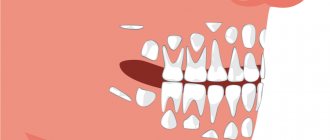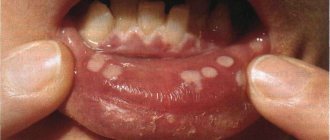In 6-10 year old children, baby teeth often fall out - a harbinger of the appearance of permanent teeth in their place. This fact should not cause any particular concern. However, there are cases when real teeth begin to loosen on their own. This is a signal that you need to consult a doctor without wasting time before the child’s health condition becomes dangerous. Loosening of baby teeth is a sure sign of a malfunction in the immune system.
Loosening of permanent teeth is a sign of both emerging diseases in the oral cavity and sudden problems with internal organs. The most common manifestations are:
- Periodontitis;
- Inflammation of the gums;
- Caries;
- Generalized metabolic disorders;
- Injuries.
If you find that your child has one or more molars that are loose, contact your dentist immediately. In some cases, the tooth root may become loose due to not entirely successful heredity - the root of the new tooth does not grow well into the jaw. It is necessary to check whether the parents of this child had such cases.
Periodontitis
This disease manifests itself at the age of 9 years - on average in 4% of children. When it occurs, the tissues surrounding the tooth become inflamed, and it begins to wobble. The basis of this process is the loss of properties. Inherent in tissues that have not yet fully matured. Here lies the main reason why teeth become loose and fall out.
To exclude such an unfavorable scenario, timely and proper teeth cleaning is needed. In childhood and adolescence, increased load on the same teeth (on the one hand), or the absence of products elastic enough for chewing, which allow, like a kind of simulator, to train growing teeth, is unacceptable. After all, what is trained during growth is what develops comprehensively.
The gums are inflamed and swollen
If the gums are not very swollen, brushing your teeth with a hard brush may be the cause. But if your gums are swollen and inflamed significantly, you need to go to the dentist. Most likely, the matter is due to the inflammatory process and infection of the gum or tooth tissue. When the gums near the tooth are swollen and painful, this is characteristic of gumboil - inflammation of the periosteum. This is a dangerous disease that can lead to widespread infection.
Swollen and bleeding gums can be a sign of gingivitis, an infectious inflammation. It can then affect deeper tissues and cause a serious disease called periodontitis. In this case, patients complain that their gums are swollen and their teeth are loose.
One of the most dangerous diseases is a dental cyst. A benign neoplasm forms in the root area, it gradually increases in size, causing pain and swelling of the gums.
In any case, make an appointment with your dentist as soon as possible to avoid making the situation worse.
Caries
Caries in childhood and adolescence develops much more rapidly than in adults. With it, the enamel is rapidly affected first, then the carious cavity penetrates the dentin and reaches the pulp. The last stage can lead to pulpitis and the need for drilling of the dental canal. The tooth enamel itself in children is immature - it is the most vulnerable, that is, it does not resist caries damage as actively as it does in adults. The maturation of tooth enamel continues for up to several years; it is necessary to brush your teeth twice a day, as doctors advise, in order to prevent the parasitic process.
Caries also manifests itself from the inside or from below - it is not the enamel of the crown or even the neck of the tooth that is affected, but the root, or the underlying structures begin to collapse. You can guess this by the fact that the tooth suddenly began to loosen.
When teeth start to loosen and fall out
Children notice their first loose crown at four or five years of age. Most often, the process of loss stretches over a very long period. For many children it continues until adolescence. For most children, by the age of 13-14 years, the change in chewing organs ends. All temporary units gave way to molars and molars. Usually, the root organs erupt painlessly. But, for some guys, before they fall out, their teeth may become loose and hurt. Children experience discomfort and anxiety. If development occurs normally and the child is healthy, the change of chewing organs will take place without complications.
- The rudiments of permanent units are present in every newborn.
- All 5-6 years they continue to develop.
- When the root organ breaks through the gum tissue upward, the resorbed temporary unit allows it to pass through.
- When a baby crown is unstable, it means that it no longer has roots, and only gum tissue holds it in place.
If a child’s baby tooth is loose without signs of pathology, it means that it is being pushed out by a permanent organ. First, children lose the front incisors of the lower jaw, and then the upper organs. It happens that the back or upper teeth weaken and fall out first. In this case, you need to see a dentist. The doctor will diagnose and, if necessary, prescribe therapeutic procedures.
General diseases of the body
Children's teeth can also become loose due to systemic diseases. They are most often based on a violation of the blood flow of individual tissues adjacent to the teeth, or metabolic disorders. These include psoriasis, diabetes mellitus and diabetes insipidus, thyroid pathologies, congenital connective tissue disorders and several other diseases.
All these destabilizing factors lead to obstruction of blood flow through the capillaries in the body. The gums and pulp in the tooth are rich in microcapillaries, through which blood delivers oxygen and nutrients to the teeth, and removes waste products and excess carbon dioxide. If these processes are untimely, degenerative phenomena occur in which tissues starve, as a result, their growth and renewal stop, and their accelerated wear and degradation occurs. This causes the weakened tooth (or several teeth) to wobble and may fall out.
Injuries
Many children find it impossible to sit still. And some of them sometimes fall. If the injury occurs in the vicinity of the jaws, the teeth may also suffer. There are often cases where a child knocked out one or even two or three teeth during a fall. But tooth fractures are not always open - cracks and root fractures can also occur - the tooth tilts to the side, and accordingly, it immediately begins to wobble.
Dental injuries also appear when a child suffers from bruxism (grinding his teeth in his sleep), or tried to chew, for example, a candy that was too hard, or, for example, got a stone in the cereal from which the porridge was cooked.
A man grinds his teeth in his sleep
There are times when a person involuntarily grinds his teeth. The problem is known as bruxism. It mainly occurs in children under 7 years of age. Most often this happens in a dream or during a moment of deep immersion in one’s thoughts. The facial muscles become overstrained, which causes a spasm: the person clenches his teeth tightly. This causes tooth enamel to wear away, jaw joints to wear out and begin to ache, causing headaches and insomnia.
Why do people grind their teeth in their sleep? The main reasons are emotional fatigue that has accumulated during the day, an incorrect bite, due to which the muscles are constantly tense. It may also be due to poor posture, in particular problems in the cervical spine.
You can find out why your teeth grind at night during a comprehensive examination at a dental clinic. We will solve the problem with the help of medicinal drops. These are comfortable plates that you put on your teeth at night. They will help your muscles tone up.
Treatment
When a child complains of looseness and pain in one or more molars, urgently visit the dentist with him. It is the dentist who will decide whether it is possible for a child not to lose a loose tooth. The doctor will take a number of measures to save the problematic tooth, which will avoid its loss and unpleasant consequences in the future. Of course, the tooth can later be replaced “from scratch” (along with a pin) - but it is better to try to preserve the original one.
When the cause of tooth loss is periodontitis or gingivitis, it is necessary to urgently clean the teeth of plaque, as well as prevent the development of inflammation that has already begun. It is possible that the teeth are splinted - this will stop their ongoing loosening.
In the event of a tooth injury, the question is raised about the possibility of saving it. When the damage is small, it is possible to preserve all intact dental tissues - they will help facilitate the process of prosthetics, becoming the “foundation” for a renewed tooth. If caries has developed, after a thorough examination, an attempt is made to save the molar. When the damage is too great, the tooth is simply removed to prevent it from rotting and damage to internal organs due to infection in the blood. If the carious cavity is small, the tooth is filled - nerves and blood vessels are removed from the pulp, disinfected with medications, and then dental cement is injected - an adhesive base that, after hardening, resembles hard dental tissue; In turn, a seal is installed on it.
If no visible damage to the teeth is found, the child undergoes a comprehensive medical examination. If any diseases are detected, he undergoes timely treatment.
To pull out or not
Units are removed according to indications. They can be absolute and relative.
- Severe carious destruction, when the tooth has darkened, therapy is impossible.
- The eruption of the root organs precedes the loss of mammary units. In such a situation, the tooth needs to be pulled out.
- Multiple severe fistulas on the gingival tissues.
- Large root cysts.
- Pulpitis in severe form.
- Periodontitis, other dental diseases.
If a loose chewing organ does not fall out on its own and causes discomfort to the baby, it is usually removed, as it can lead to gum inflammation. Anesthesia is not used in this situation. Some babies push their teeth out with their tongue. Such units come off when biting into hard foods. For minor bleeding, apply a cotton swab, which must be moistened with a disinfectant. You should remove a baby tooth that is hanging by a thread so that it does not fall out at night or block your breathing.
- First you need to cool the gum with a piece of ice.
- Then you need to grab the unit with a paper napkin and quickly turn it around its axis.
- A sterile gauze pad should be applied to the wound site; a clean handkerchief will do.
Pulling out a baby tooth is not difficult. After the procedure, it is useful to rinse your mouth with chamomile decoction. It's a different matter when the little one cries and does not agree to open his mouth. You should not scold the child at the same time. You need to see a dentist. The doctor will help if:
- The root unit grows until the mammary organ prolapses; there is a fear that it will be crooked;
- Temporary incisors and molars fell out early;
- Many people in the family wore braces;
- The temperature has increased and lasts for 2-3 days;
- The tooth is loose, making it difficult to chew;
- The unit is broken, it hurts the tongue;
- Severe carious lesions;
- Diagnosed with periodontal disease or rickets, diabetes mellitus or anemia.
It happens that the chewing organs become loose, but do not fall out on their own. Most likely, there is excess calcium in the baby’s body. The quality of life of children depends on how quickly parents react.
Prevention
Taking care of your teeth is preserving the attractiveness of your smile, which is the calling card of both a child and, subsequently, an adult who sets important goals for himself. This means that taking care of your teeth should be timely, and it is better to get used to this right away in childhood. Parents will ensure that the child carries out high-quality sanitation of the oral cavity and teeth every day, and twice a year he needs to visit the dentist. Equally important is a balanced diet. If problems do affect at least one tooth, do not ignore them: you are responsible for the health of your child.
Spots appeared on the enamel of the teeth
If stains appear on the enamel of your teeth, do not try to get rid of them yourself and make an appointment with a specialist. These changes can be the result of poor nutrition, bad habits, or a symptom of diseases, not only dental ones. Yellow spots on tooth enamel are often the result of poor teeth cleaning; multiple white spots are a sign of fluorosis.
A dark spot on tooth enamel can be a smoker’s plaque, a manifestation of root caries, or dysbacteriosis. Brown stains on tooth enamel become brown over time; initially they are yellow or white.
Black spots on tooth enamel may appear on a pulpless tooth from which the nerve has been removed. In any case, it is necessary to understand the cause of this symptom and undergo treatment. The first step is professional teeth cleaning. If it is not a disease, but poor hygiene and bad habits, it is often enough to get rid of stains.
Be careful about your oral health! The main symptoms warn of diseases that require visiting a dentist. Don't self-medicate and don't expect everything to go away on its own. Timely treatment will save you from complications and unnecessary costs for restoring your health.
